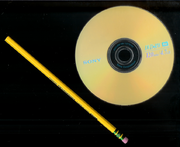
DVD
Did you know...
The articles in this Schools selection have been arranged by curriculum topic thanks to SOS Children volunteers. Click here for more information on SOS Children.
DVD (also known as "Digital Versatile Disc" or "Digital Video Disc" - see Etymology) is a popular optical disc storage media format. Its main uses are video and data storage. Most DVDs are of the same dimensions as compact discs ( CDs) but store more than 6 times as much data.
Variations of the term DVD often describe the way data is stored on the discs: DVD-ROM has data which can only be read and not written, DVD-R and DVD+R can be written once and then functions as a DVD-ROM, and DVD-RAM, DVD-RW, or DVD+RW holds data that can be erased and thus re-written multiple times. The wavelength used by standard DVD lasers is 650 nm .
DVD-Video and DVD-Audio discs respectively refer to properly formatted and structured video and audio content. Other types of DVDs, including those with video content, may be referred to as DVD-Data discs. The term "DVD" is commonly misused to refer to high definition optical disc formats in general, such as HD DVD, its official successor, and Blu-ray, its rival.
History
| Optical discs |
|---|
|
General
|
|
Optical media types
|
|
Standards
|
|
See also
|
In 1993, two high-density optical storage standards were being developed; one was the MultiMedia Compact Disc, backed by Philips and Sony, and the other was the Super Density disc, supported by Toshiba, Time Warner, Matsushita Electric, Hitachi, Mitsubishi Electric, Pioneer, Thomson, and JVC. IBM's president, Lou Gerstner, acting as a matchmaker, led an effort to unite the two camps behind a single standard, anticipating a repeat of the costly videotape format war between VHS and Betamax in the 1980s.
Philips and Sony abandoned their MultiMedia Compact Disc and fully agreed upon Toshiba's SuperDensity Disc with only one modification, namely changing to EFMPlus modulation. EFMPlus was chosen as it has a great resilience against disc damage such as scratches and fingerprints. EFMPlus, created by Kees Immink, who also designed EFM, is 6% less efficient than the modulation technique originally used by Toshiba, which resulted in a capacity of 4.7 GB as opposed to the original 5 GB. The result was the DVD specification, finalized for the DVD movie player and DVD-ROM computer applications in December 1995. In May 1997, the DVD Consortium was replaced by the DVD Forum, which is open to all other companies.
Etymology
"DVD" was originally used as an initialism for the unofficial term "digital videodisk". It was reported in 1995, at the time of the specification finalization, that the letters officially stood for "digital versatile disc" (due to non-video applications), however, the text of the press release announcing the specification finalization only refers to the technology as "DVD", making no mention of what (if anything) the letters stood for. A newsgroup FAQ written by Jim Taylor (a prominent figure in the industry) claims that four years later, in 1999, the DVD Forum stated that the format name was simply the three letters "DVD" and did not stand for anything.
The official DVD specification documents have never defined DVD. Usage in the present day varies, with "DVD", "Digital Video Disc", and "Digital Versatile Disc" being the most common.
The DVD Forum website has a section called "DVD Primer" in which the answer to the question, "What does DVD mean?" reads, "The keyword is 'versatile.' Digital Versatile discs provide superb video, audio and data storage and access -- all on one disc."
DVD capacity
| Single layer capacity | Dual/Double layer capacity | |||
|---|---|---|---|---|
| Physical size | GB | GiB | GB | GiB |
| 12 cm, single sided | 4.7 | 4.37 | 8.54 | 7.95 |
| 12 cm, double sided | 9.4 | 8.74 | 17.08 | 15.90 |
| 8 cm, single sided | 1.4 | 1.30 | 2.6 | 2.42 |
| 8 cm, double sided | 2.8 | 2.61 | 5.2 | 4.84 |
The 12 cm type is a standard DVD, and the 8 cm variety is known as a mini-DVD. These are the same sizes as a standard CD and a mini-CD.
Note: GB here means gigabyte in the SI sense, i.e. 109 (or 1,000,000,000) bytes; GiB is used for gibibyte, equal to 230 (or 1,073,741,824) bytes. For reference, most computer operating systems display file sizes in gibibytes, mebibytes, and kibibytes.
Example: A disc with 8.54 GB capacity is equivalent to: (8.54 × 1,000,000,000) / 1,073,741,824 ≈ 7.95 GiB.
Each DVD sector contains 2418 bytes of data, 2048 bytes of which are user data.

Capacity Note: There is a small difference in capacity (storage space) between + and - DL DVD formats. For example, the 12 cm single sided disc has capacities:
| Disc Type | Sectors | bytes | GB | GiB |
|---|---|---|---|---|
| DVD-R SL | 2,298,496 | 4,707,319,808 | 4.7 | 4.384 |
| DVD+R SL | 2,295,104 | 4,700,372,992 | 4.7 | 4.378 |
| DVD-R DL | 4,171,712 | 8,543,666,176 | 8.5 | 7.957 |
| DVD+R DL | 4,173,824 | 8,547,991,552 | 8.5 | 7.961 |
Capacity nomenclature
The five basic types of DVD are referred to by their approximate capacity in gigabytes.
| DVD type | Name |
|---|---|
| Single sided, single layer | DVD-5 |
| Single sided, dual layer | DVD-9 |
| Double sided, single layer | DVD-10 |
| Double sided, dual layer on one side, single on other | DVD-14 |
| Double sided, dual layer on both sides | DVD-18 |
Technology
DVD uses 650 nm wavelength laser diode light as opposed to 780 nm for CD. This permits a smaller spot on the media surface (1.32 µm for DVD versus 2.11 µm for CD).
Writing speeds for DVD were 1×, that is 1350 kB/s (1318 KiB/s), in the first drives and media models. More recent models at 18× or 20× have 18 or 20 times that speed. Note that for CD drives, 1× means 153.6 kB/s (150 KiB/s), 9 times slower. DVD FAQ
Speed
| Drive speed | Data rate | Write time for Single Layer DVD | |
|---|---|---|---|
| 1X | 10.55 Mbit/s | 1.32 MB/s | 61 min. |
| 2X | 21.09 Mbit/s | 2.64 MB/s | 30 min. |
| 4X | 42.19 Mbit/s | 5.27 MB/s | 15 min. |
| 8X | 84.38 Mbit/s | 10.55 MB/s | 8 min. |
| 16X | 168.75 Mbit/s | 21.09 MB/s | 4 min. |
DVD recordable and rewritable
HP initially developed recordable DVD media from the need to store data for back-up and transport.
DVD recordables are now also used for consumer audio and video recording. Three formats were developed: DVD- R/ RW (minus/dash), DVD+ R/ RW (plus), DVD-RAM.
Dual layer recording
Dual Layer recording allows DVD-R and DVD+R discs to store significantly more data, up to 8.5 gigabytes per side, per disc, compared with 4.7 gigabytes for single-layer discs. DVD-R DL was developed for the DVD Forum by Pioneer Corporation, DVD+R DL was developed for the DVD+RW Alliance by Philips and Mitsubishi Kagaku Media (MKM).
A Dual Layer disc differs from its usual DVD counterpart by employing a second physical layer within the disc itself. The drive with Dual Layer capability accesses the second layer by shining the laser through the first semi-transparent layer. The layer change mechanism in some DVD players can show a noticeable pause, as long as two seconds by some accounts. This caused more than a few viewers to worry that their dual layer discs were damaged or defective, with the end result that studios began listing a standard message explaining the dual layer pausing effect on all dual layer disc packaging.
DVD recordable discs supporting this technology are backward compatible with some existing DVD players and DVD-ROM drives. Many current DVD recorders support dual-layer technology, and the price is now comparable to that of single-layer drives, though the blank media remains more expensive. The recording speeds reached by dual-layer media are still well below those of single-layer media.
DVD-Video
DVD-Video is a standard for storing video content on DVD media. In the U.S., weekly DVD-Video rentals first out-numbered weekly VHS cassette rentals in June 2003, illustrating the rapid adoption rate of the technology in the marketplace.
Though many resolutions and formats are supported, most consumer DVD-Video discs use either 4:3 or anamorphic 16:9 aspect ratio MPEG-2 video, stored at a resolution of 720×480 ( NTSC) or 720×576 ( PAL) at 29.97 or 25 FPS. Audio is commonly stored using the Dolby Digital (AC-3) or Digital Theatre System (DTS) formats, ranging from 16-bits/48 kHz to 24-bits/96 kHz format with monaural to 7.1 channel " Surround Sound" presentation, and/or MPEG-1 Layer 2. Although the specifications for video and audio requirements vary by global region and television system, many DVD players support all possible formats. DVD-Video also supports features like menus, selectable subtitles, multiple camera angles, and multiple audio tracks.
DVD-Audio
DVD-Audio is a format for delivering high-fidelity audio content on a DVD. It offers many channel configuration options (from mono to 7.1 surround sound) at various sampling frequencies (up to 24-bits/192 kHz versus CDDAs 16-bits/44.1 kHz). Compared with the CD format, the much higher capacity DVD format enables the inclusion of considerably more music (with respect to total running time and quantity of songs) and/or far higher audio quality (reflected by higher linear sampling rates and higher vertical bit-rates, and/or additional channels for spatial sound reproduction).
Despite DVD-Audio's superior technical specifications, there is debate as to whether the resulting audio enhancements are distinguishable in typical listening environments. DVD-Audio currently forms a niche market, probably due to the very sort of format war with rival standard SACD that DVD-Video avoided.
Security
DVD-Audio discs employ a robust copy prevention mechanism, called Content Protection for Prerecorded Media (CPPM) developed by the 4C group (IBM, Intel, Matsushita, and Toshiba).
To date, CPPM has not been "broken" in the sense that DVD-Video's CSS has been broken, but ways to circumvent it have been developed. By modifying commercial DVD(-Audio) playback software to write the decrypted and decoded audio streams to the hard disk, users can, essentially, extract content from DVD-Audio discs much in the same way they can from DVD-Video discs.
Successors
There are several possible successors to DVD being developed by different consortia. Sony/ Panasonic's Blu-ray Disc (BD) as a rival to DVD forum's HD DVD, the "Official" successor designed by Toshiba. Both began to gain traction in 2007, and next-generation technologies such as Maxell's Holographic Versatile Disc (HVD) and 3D optical data storage are being actively developed.
On November 19, 2003, the DVD Forum decided by a vote of eight to six that HD DVD will be its official HD successor to DVD. In spite of this, both BD and HD DVD have already severely hampered the adoption of any successor to DVD through a lack of the very cooperation that fostered DVD's success.


